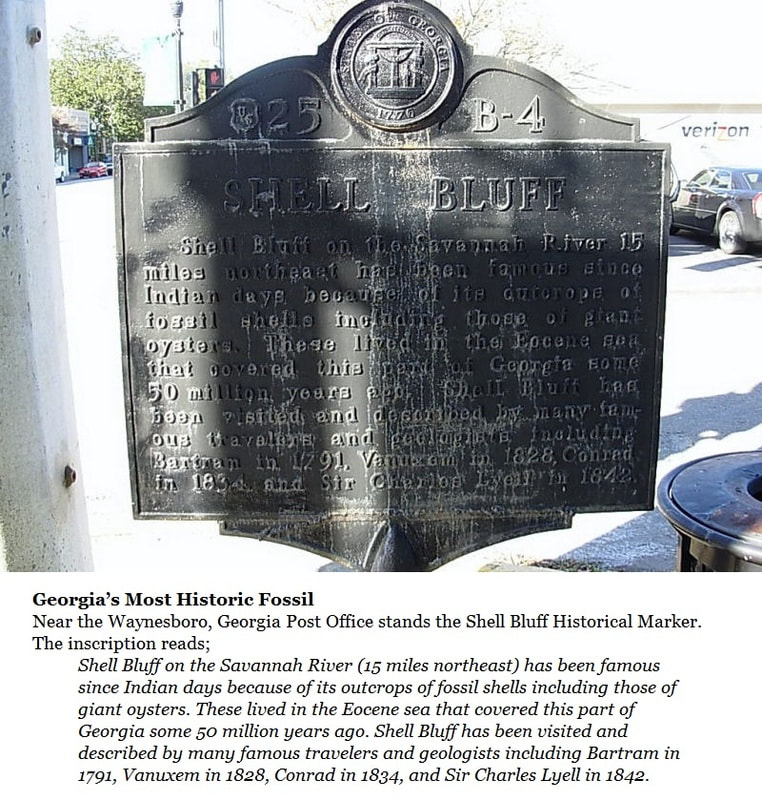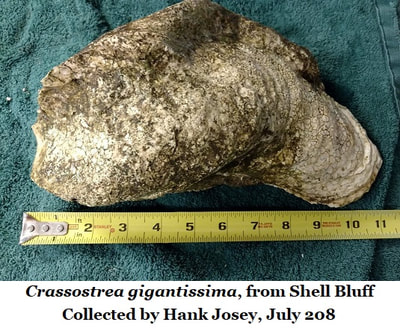14K: Shell Bluff
Georgia’s Most Historic Fossils
By
Henry N. Josey, PharmD.
Filed August 20, 2018
Georgia’s Most Historic Fossils
By
Henry N. Josey, PharmD.
Filed August 20, 2018
Shell Bluff, on the Savannah River in Eastern Burke County, Georgia, is beyond a doubt the most historically significant fossil site in the state. Its history dates back centuries, even to the pre – colonial period when Native Americans encamped in the area. Hernando de Soto explored the site in 1540. William Bartram, the father of American botany, visited in 1765 and first described the large fossil oysters found there. John Finch described these oysters in 1824, naming them Ostrea gigantissima in a paper read before the Academy of Natural Sciences in Philadelphia. Vanuxem visited the site in 1824 and Timothy A. Conrad in 1834. Conrad was the first researcher to identify the strata as Eocene age. Charles Lyell stopped at Shell Bluff on January 2, 1842 and spent several days collecting specimens.
Shell Bluff is the type locality for the fossil giant oyster Crassostrea gigantissima. The species’ name has evolved through several iterations including Ostrea gigantissima, Ostrea georgiana, and several others. This species is relatively common in Eocene deposits of Georgia although nowhere else did this species appear so numerous or grow so large, excepting perhaps Griffin’s Landing, 17 miles downstream on the Savannah River. Specimens up to 22 inches in length have been documented there although these are few and far between now.
Several geologic units are present at the site. The most basal unit is the McBean Member of the Lisbon Formation which is middle Eocene in age. It contains abundant mollusks including the middle Eocene guide fossil Ostrea sellaeformis as well as many other species. Above this is the Clinchfield Sand Formation of late Eocene age. This layer has produced vertebrate fossils including shark and ray teeth as well as whale and dugong bones. Finally, the uppermost layer consists of the Griffin’s Landing Member of the Dry Branch Formation. This is the layer which yields the Crassostrea gigantissima oysters which give Shell Bluff its name.
Several geologic units are present at the site. The most basal unit is the McBean Member of the Lisbon Formation which is middle Eocene in age. It contains abundant mollusks including the middle Eocene guide fossil Ostrea sellaeformis as well as many other species. Above this is the Clinchfield Sand Formation of late Eocene age. This layer has produced vertebrate fossils including shark and ray teeth as well as whale and dugong bones. Finally, the uppermost layer consists of the Griffin’s Landing Member of the Dry Branch Formation. This is the layer which yields the Crassostrea gigantissima oysters which give Shell Bluff its name.
The author traveled to this locality in July 2018 for the purpose of describing the site and collecting samples. This site is now in the hands of private landowners, and visitors must have permission to examine the site. Access by land is almost impossible. The bluff can only be reached via Shell Bluff Landing, approximately 300 yards downstream from Shell Bluff. The author found most of the upper layers of the site being slowly covered with soil and overgrown with forest. However, this has been significant slumping of the upper layers on to the river band so some late Eocene material is available for study. The bluff itself rises almost 150 feet high above the banks of the Savannah River.
The following species have been identified from Shell Bluff, both in the literature and the author’s personal research collection.
Astrangia Coral
Aturia alabamiensis Nautiloid
Calyptraea aperta Snail
Carcharias accuttisima Sand tiger shark
Carophyllia subdichotoma Solitary coral
Chlamys membranosus Scallop
Corbula alabamiensis Basket clam
Corbula fossata Basket clam
Corbula oniscus Basket clam
Crassatellites protextus Clam
Crassostrea gigantissima Giant oyster
Crepidula lirata Slipper snail
Cytherea discoidalis Clam
Cytherea perovata Clam
Cytherea poulsoni Clam
Cytherea texacola Clam
Dendrophyllia Stony cup coral
Dentalium thalloides Tusk shell
Endopachys maclurii Solitary coral
Fusus irrasus Sea snail
Fusus limulus Sea snail
Fusus trabeatus Sea snail
Glycymeris trigonella Bittersweet clam
Leda pharcida Clam
Lunulites bouei Bryzoa
Mesalia claibornensis Sea Snail
Nucula magnifica Nut clam
Ostrea alabamiensis Oyster
Ostrea sellaeformis Oyster
Oxyrhina desori Mako shark
Plejona petrosa Volute shell
Pteropsis lapidosa Clam
Turritella humerosa Sea Snail
Turritella vetusia Sea Snail
Turritella vetusta Sea Snail
Venericardia alticosta Cockle shell
Venericardia planicosta Cockle shell
References
Edwards, Elliot O., Jr. “Shell Bluff – A Fossiliferous Ridge, the Site of the Extinct Oyster Crassostrea gigantissima and History of It Identification.” 2016. Georgia Academy of Science.
Huddlestun, P. F. and J. H. Summerour. The Lithostratigraphic Framework of the Uppermost Cretaceous and Lower Tertiary of Eastern Burke County, Georgia. 1996. Georgia Department of Natural Resources, Georgia Geologic Survey. Bulletin 127. Atlanta, Georgia.
Richards, H. G. Illustrated Fossils of the Georgia Coastal Plain. 1969.Georgia Mineral Newsletter.
Toulmin, Lyman D. Stratigraphic Distribution of Paleocene and Eocene Fossils in the Eastern Gulf Coast Region. 1977. Geological Survey of Alabama. Monograph 13. University, Alabama.
Veatch, O. V and W. L. Stephenson. Preliminary Report on the Geology of the Coastal Plain of Georgia. 1911. Geological Survey of Georgia. Bulletin 26. Foote & Davies: Atlanta, GA.
Walker, Cyril and David Ward. Eyewitness Handbooks: Fossils. 1992. Dorling Kindersley, Inc. New York.






